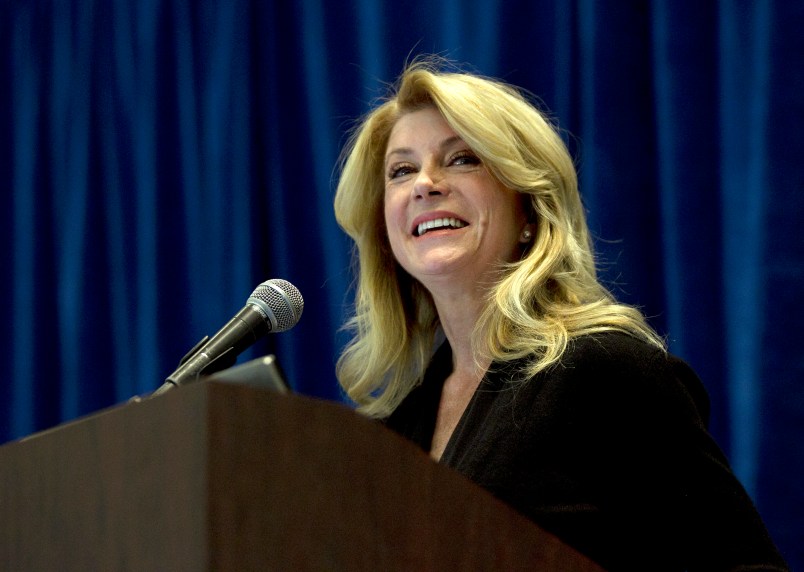AUSTIN, Texas (AP) — Battleground Texas, the major Democratic effort aimed at turning one of the reddest states blue, celebrated its first birthday this week with cocktails at a swank Austin bar, hosting one last party before the project’s first significant test in Tuesday’s primary election.
The initiative organized by Jeremy Bird, President Barack Obama’s former field organizer, has raised more than $3 million, signed up 12,000 volunteers and attempted more than 370,000 phone calls and door-knocks to boost the Democratic Party, according to the organizing group’s executive director, Jenn Brown. The group hopes to take advantage of the state’s changing demographics to increase the Democratic vote, using a neighborhood mobilizing model that produced results in Obama’s presidential campaigns.
The March 4 Democratic primary will reveal how much the group has accomplished on the road to the general election in November.
Democrats hope to make Texas a battleground state by 2016 to, at the very least, force the GOP to divert resources to preserving their hold on the second largest number of electoral college seats in the country. If Democrats could routinely win in Texas, along with their strongholds in California and New York, they could hold the White House for years to come.
But no Democrat has won a statewide election since 1994, and participation in the primary, as a percentage of the state’s population, has steadily dropped to 590,000 in 2012. The one exception was the 2008 primary, in which Obama faced off against Hillary Clinton, a race that brought out a record 2.8 million voters.
“It gives you a sense of what is possible if you have very competitive mobilization efforts going on,” said James Henson, a political scientist at the University of Texas at Austin, an expert on voter behavior in Texas.
“There’s a chicken and egg question, do you get people mobilized and then you get more competitive races? Or do you get more competitive races, and then that helps mobilize people?”
Republicans say that registering more voters in the fast-growing state won’t necessarily help Democrats because Texas residents, including many Hispanics, tend to be conservative.
“The center-right is the vast majority in this state, so you can register all the voters you want,” said Republican Party Chairman Steve Munisteri.
Enthusiasm for Democratic gubernatorial candidate Wendy Davis has sped up the organizing group’s timeline for making Texas a battleground state, said Brown. Davis, 50, became a hero to abortion rights advocates when she conducted an 11-hour filibuster in the Texas Senate last year that temporarily blocked a new abortion measure. Her personal story of being a divorced teenage mother who went on earn a law degree and win elective office has added to her celebrity.
Until Davis’ emergence, Democrats’ hopes of breaking through had originally centered on 2020, when Hispanics will become the majority in Texas.
Nevertheless, expectations for next week’s primary have been tamped down by the fact that Davis doesn’t face a serious Democratic challenger. Greg Abbott, the state attorney general, is the presumptive Republican nominee for governor.
Brown said the group is far more focused on turning out the vote in November, when Battleground Texas will fully activate the neighborhood networks to staff phone banks, knock on doors and help Democratic voters get to the polls. Past Democratic campaigns have relied primarily on television and direct mail, only to see the party’s share of the vote top out at 42 percent.
U.S. Rep. Joaquin Castro, a rising star in the Democratic Party from San Antonio, said Democrats see opportunity in an electorate that is not nearly as ethnically diverse as the state’s population. Texas also ranks last in the nation in voter turnout.
“In Texas, one of the reasons we have such an abysmal voter participation rate is because people are just not being spoken to and Battleground Texas is helping to change that,” he said. Past Democratic campaigns have concentrated on mainly white likely voters who vote overwhelming Republican.
The GOP’s Munisteri said Republicans have also stepped up outreach programs to minorities and sent activists to minority events, such as Asian lunar new year celebrations and Hispanic festivals. The party has a team of fluent Spanish speakers creating social media campaigns.
GOP leaders crowed when Gallup released an analysis of its 2012 daily tracking polls that revealed that while 51 percent of Hispanics outside of Texas identify with the Democratic Party, only 46 percent of Texas Hispanics do.
Democrats acknowledge they must do better.
“The real issue is that we haven’t built the structures to engage the Latino community,” Brown said. “That’s the problem we’re working to address.”
___
Follow Chris Tomlinson on Twitter at http://twitter.com/cltomlinson
Copyright 2014 The Associated Press. All rights reserved. This material may not be published, broadcast, rewritten or redistributed.






